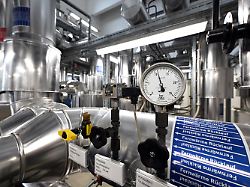Up to 20 million connections?
Association considers significantly more district heating possible
6/5/2023 7:13 am
So far, only a few million homes have been heated with district heating. A trade association believes that this can be significantly improved. Perspectively, one wants to come to 18 to 20 million apartments. District heating is the key for climate-neutral cities in Germany.
The district heating industry believes it is possible for the number of households connected to the heating network to triple by 2050. “For this, however, the companies need planning security and suitable funding conditions,” said the deputy managing director of the AGFW trade association, John Miller.
Around 6 million of the 43 million apartments are currently heated with district heating. Perspectively, one wants to come to 18 to 20 million, especially in apartment buildings in the cities and densely populated areas. “District heating is the key to the issue of climate-neutral cities in Germany. Now is exactly the right time to set the course.”
Miller emphasized that a large number of renewable sources and technologies could be connected to the district heating infrastructure, which would make the heating networks climate-neutral by 2045. As examples, he named large heat pumps, geothermal energy, solar thermal energy, biomass or waste heat from industry or data centers. In this context, he emphasized the leverage effect of switching to renewable energies. If, for example, a coal-fired combined heat and power plant were then operated with climate-neutral fuels or replaced by climate-neutral technologies, thousands of residential units would suddenly have switched fuel.
Call for longer transition periods
Miller was positive about the place that heating networks will be given in the planned building energy and municipal heat planning legislation. “We are glad that politicians have now woken up a bit and are focusing on district heating networks.” The association criticizes the schedule provided for in the Building Energy Act to convert existing heating networks to at least 50 percent renewable heat or waste heat by 2030. “We don’t think it’s a good idea to set this across the board for all heating networks,” said Miller.
The association calls for longer transition periods and significantly more funding, especially for the “Federal Funding for Efficient Heating Networks” (BEW) program. According to AGFW, there are around 3,800 district heating networks in Germany operated by around 500 companies. The AGFW describes itself as the “energy efficiency association for heat, cold and combined heat and power”. Around 640 companies are members, including most of the district heating providers.
